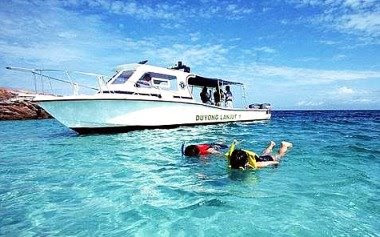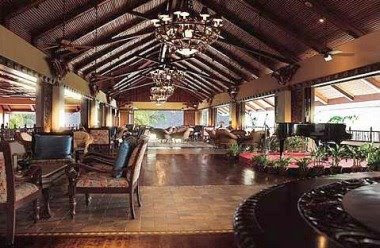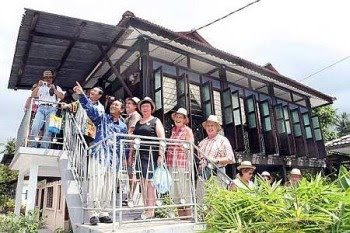Honeymoon bliss
Sunday July 6, 2008
Compiled by Faridah Begum
Honeymooning domestically is just as good as doing so abroad.
Bukit Tinggi, Pahang

None can compare to the French influenced Colmar Tropicale, which is only about an hour’s drive from the capital city of Kuala Lumpur and boasts of not just a setting but the ambience is not unlike the real towns of France that it emulates. Perfect for a weekend or just a short honeymoon, it is sure to appeal to the hearts of newly-weds for a repeated honeymoon trip.
Cameron Highlands, Pahang

The highlands offer honeymooning couples a great English setting. Not having to fork out thousands to get to the outskirts of London, you can enjoy afternoon tea, cool weather and many cold evenings together with good steamboats and Continental meals at most restaurants here.
The Andaman, Langkawi, Kedah

Situated in the picturesque Datai Bay, honeymooning couples will find the tranquillity a great help in keeping the romance burning. Lots to do with the natural setting such as bird watching, sunsets and even a round of golf if either one or both are enthusiasts.
Serai di Lanjut, Pahang

If a timeless holiday is on the cards, then this place is just right. Away from the hustle and bustle of city life coupled with the slow and easy pace here, one can just stretch out on the white sandy beaches for hours on end or play a round of golf or even go river fishing.
Pulau Perhentian, Terengganu
Many couples have met on scuba diving trips and this can account for quite a percentage of marriages. It is only right and perhaps understandable if they choose to go on a scuba diving honeymoon, especially where they first met. Pulau Perhentian may be the place or even a good alternative. Known as one of the best diving posts in the country, Pulau Perhentian is actually made up of two islands, namely Pulau Perhentian Besar and Pulau Perhentian Kecil.
Pangkor Island Resort, Pangkor, Perak
Look forward to sunset cruises, traditional Malay massages and lots of time together in the beautiful resort that was voted the best in the West Coast. With a private beach exclusively for guests of the resort, you can plan many outdoor activities such as jungle trekking, archery, parasailing and cycling.
Permai Rainforest Resort, Kuching, Sarawak

If your wish is to have a taste of everything, then this is the perfect getaway for you. You get a package of the sun, sea, beach, mountains, waterfalls and modern facilities all in one place. Just 30 minutes from Kuching, you will want for nothing except more time to do all the things you want together as a couple, and more.
Tanjong Jara, Terengganu

Noted for its pristine turquoise waters and its hidden location, there are lots that a honeymooning couple can do here. For one, it boasts of a good spa, just right for a couple that has gone through the mill with the preparation of the wedding and the crush of relatives. It also provides the couple a chance to be just by themselves and enjoy their newly entwined lives together.
Pulai Springs Desaru, Johor

Designed like an ancient Malay palace, Pulai Springs is on one of the unspoilt beaches south of the East Coast in the peninsula. Like most resorts, it promises the excitement of a beach resort yet maintains a calm and serene atmosphere that is conducive for honeymooning and gives couples time to acquaint themselves further besides enjoying the array of activities available here such as golf and jungle trekking, and with an untouched forest that casts a romantic glow in the evenings.
Nexus Resort Karambunai, Sabah

Winner of many prestigious awards, this place has been described as heaven on earth with its natural setting and the numerous activities that come with it. A lagoon park fulfils one’s desires of water games and the 30ha nature park within the resort gives honeymooning couples hours of trekking together.
-- The Sunday Metro
Sunday July 6, 2008
Compiled by Faridah Begum
Honeymooning domestically is just as good as doing so abroad.
Bukit Tinggi, Pahang

None can compare to the French influenced Colmar Tropicale, which is only about an hour’s drive from the capital city of Kuala Lumpur and boasts of not just a setting but the ambience is not unlike the real towns of France that it emulates. Perfect for a weekend or just a short honeymoon, it is sure to appeal to the hearts of newly-weds for a repeated honeymoon trip.
Cameron Highlands, Pahang

The highlands offer honeymooning couples a great English setting. Not having to fork out thousands to get to the outskirts of London, you can enjoy afternoon tea, cool weather and many cold evenings together with good steamboats and Continental meals at most restaurants here.
The Andaman, Langkawi, Kedah

Situated in the picturesque Datai Bay, honeymooning couples will find the tranquillity a great help in keeping the romance burning. Lots to do with the natural setting such as bird watching, sunsets and even a round of golf if either one or both are enthusiasts.
Serai di Lanjut, Pahang

If a timeless holiday is on the cards, then this place is just right. Away from the hustle and bustle of city life coupled with the slow and easy pace here, one can just stretch out on the white sandy beaches for hours on end or play a round of golf or even go river fishing.
Pulau Perhentian, Terengganu
Many couples have met on scuba diving trips and this can account for quite a percentage of marriages. It is only right and perhaps understandable if they choose to go on a scuba diving honeymoon, especially where they first met. Pulau Perhentian may be the place or even a good alternative. Known as one of the best diving posts in the country, Pulau Perhentian is actually made up of two islands, namely Pulau Perhentian Besar and Pulau Perhentian Kecil.
Pangkor Island Resort, Pangkor, Perak
Look forward to sunset cruises, traditional Malay massages and lots of time together in the beautiful resort that was voted the best in the West Coast. With a private beach exclusively for guests of the resort, you can plan many outdoor activities such as jungle trekking, archery, parasailing and cycling.
Permai Rainforest Resort, Kuching, Sarawak

If your wish is to have a taste of everything, then this is the perfect getaway for you. You get a package of the sun, sea, beach, mountains, waterfalls and modern facilities all in one place. Just 30 minutes from Kuching, you will want for nothing except more time to do all the things you want together as a couple, and more.
Tanjong Jara, Terengganu

Noted for its pristine turquoise waters and its hidden location, there are lots that a honeymooning couple can do here. For one, it boasts of a good spa, just right for a couple that has gone through the mill with the preparation of the wedding and the crush of relatives. It also provides the couple a chance to be just by themselves and enjoy their newly entwined lives together.
Pulai Springs Desaru, Johor

Designed like an ancient Malay palace, Pulai Springs is on one of the unspoilt beaches south of the East Coast in the peninsula. Like most resorts, it promises the excitement of a beach resort yet maintains a calm and serene atmosphere that is conducive for honeymooning and gives couples time to acquaint themselves further besides enjoying the array of activities available here such as golf and jungle trekking, and with an untouched forest that casts a romantic glow in the evenings.
Nexus Resort Karambunai, Sabah

Winner of many prestigious awards, this place has been described as heaven on earth with its natural setting and the numerous activities that come with it. A lagoon park fulfils one’s desires of water games and the 30ha nature park within the resort gives honeymooning couples hours of trekking together.
-- The Sunday Metro


























